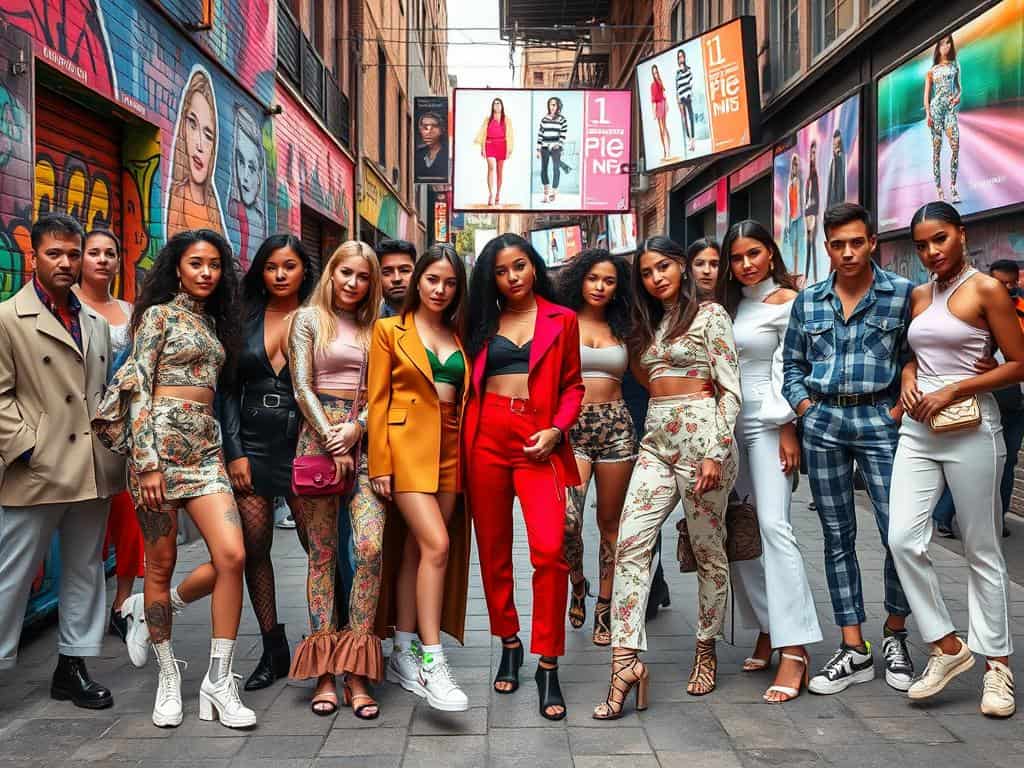Did you know Roblox saw 165 billion avatar updates and over 1.65 billion digital fashion buys in just nine months? This points to how fast digital fashion is growing, especially with Generation Z. With the fashion market expected to hit $3.3 trillion by 2030, old ways of making clothes cheaply are fading out.
Today, people want things that don’t harm the planet, and they prefer brands that are kind to the earth. To meet this demand, fashion is turning to innovative fashion technology. This includes smart tools like artificial intelligence and online shopping options. These steps are changing the industry in big ways. They improve how clothes are made and sold, and how well brands connect with buyers.
Key Takeaways
- The fashion industry is projected to reach $3.3 trillion by 2030.
- Young consumers demand personalized and sustainable experiences from brands.
- Digital platforms, like Roblox, showcase the growing market for digital fashion.
- Artificial intelligence and big data are transforming fashion marketing and trend predictions.
- Innovative technologies are reshaping consumer engagement within the fashion industry.
The Rise of Digital Fashion
The digital world is changing fashion for everyone. Now, we can see new styles faster than ever, thanks to social media. Social media has become a key way for trends to spread. Instagram and TikTok help new styles take off quickly. This is different from the past when seasons changed fashion.
Brands like Shein and Fashion Nova benefit from people wanting new clothes all the time. However, there’s also a growing push for sustainable fashion. More people want clothes that last and are made fairly.
Impact of Social Media on Fashion Trends
Social media shapes fashion today. It lets people see new trends right away. Brands use social media to connect with customers and build their image. Because of this, fast fashion has become very popular. People buy and throw away clothes quickly.
But, there’s a growing interest in slow fashion and doing good for the planet. People are talking more about ethical fashion. For example, Pinterest has seen a 71% rise in searches for sustainable fashion. It shows that people are thinking more about what they buy.
Emphasis on Sustainability and Ethical Practices
More people care about where their clothes come from. They want to support brands that are good for the environment. This change is making brands think about how they make clothes. They’re trying to use their power to do good.
By focusing on sustainability, brands can build trust with their customers. People want to buy from companies that make ethical choices. This could change what success looks like in fashion.

Innovative Technologies Shaping the Fashion Industry
The fashion industry is changing fast, thanks to new tech. 3D design is one big game-changer. It lets brands try out new ideas quickly. Now, they can see how clothes will look without making a real sample. This cuts down the time it takes to sell new styles from months to just weeks.
3D Designs and Virtual Clothing
3D design is now a must-have for fashion brands. They’re using it to make shopping cooler and more interactive. Customers can see how clothes look on them without leaving home. Big names like Gucci and Tommy Hilfiger are all over this trend. They’re making it fun and easy to shop online.
Artificial Intelligence in Fashion
AI is changing fashion in big ways. It’s great for figuring out what’s in style and keeping stock in check. 2023 is a big year for AI. Retailers can make shopping feel personal with smart algorithms. Services like Stitch Fix use AI to pick clothes just for you. And platforms like Edited help brands decide what to sell with up-to-the-minute data.
Integration of E-commerce in Fashion
E-commerce and tech are teaming up to keep shoppers clicking longer. This is good news for sales. About 2.2% of people visiting fashion sites buy something. That’s why smooth online shopping is key to selling more. Plus, smarter tech means fewer returns and less waste from unsold clothes.
Conclusion
The digital transformation in fashion has changed how the industry works. It’s changing how we buy and how brands plan their strategies. In the nearing future, fashion technology will be more critical. Brands need to meet new consumer expectations in fashion. By 2030, the metaverse could make $50 billion in sales for fashion. So, companies must keep innovating and engaging their customers.
Now, online shopping is more engaging and personal. This shows how tech like AR, VR, and AI can change things. Brands like DressX are now selling digital clothes. These range from $30 to $1000. This shift towards virtual clothes shows people want to be unique. Especially Gen Z, who will soon be a big part of luxury buyers. They care a lot about being eco-friendly and ethical.
We’re seeing digital and real fashion mix to make shopping better. This also helps the environment. The future of fashion is about being innovative but also sustainable. As things change, digital fashion will be key in making fashion creative, inclusive, and green. This starts an exciting new chapter in fashion.